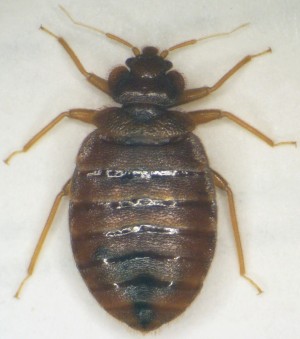 Bed Bugs On the Move - December 10, 2008 Jeff Schalau, Associate Agent, Agriculture & Natural Resources University of Arizona Cooperative Extension, Yavapai County Bed bugs have been living with humans for at least the last 4,000 years of recorded history and very likely longer. Bed bug populations declined in the second half of the 20th century. This was probably due to improved building practices, education, emphasis on prevention, and most significantly, the wide-spread use of broad spectrum insecticides. Over the last few years, there has been a minor resurgence of bed bug activity. You may be interested in some of the potential reasons for this resurgence as well as some simple steps to reduce likelihood you will bring bed bugs home during holiday travel. The resurgence is being blamed on increased travel and immigration, reduced applications of residual pesticides (due to health and safety concerns), and the insects becoming resistant to pesticides that are used. Bed bugs had become resistant to DDT by the time it was banned in the U.S. (1972) and have since become resistant to DDT in Africa where it is widely used to battle malaria. Resistance is also building to pyrethroids: a family of insecticides commonly used in over-the-counter household insecticides and repellents. Resistance occurs when we become too reliant on one pesticide and apply it repeatedly. Some individuals in the insect population are not affected as severely and survive the pesticide exposure and breed with other resistant individuals. After several generations, this leads to pesticide resistant offspring. Bed bugs exist worldwide and are in the order Hemiptera (true bugs) and family Cimicidae which includes over 100 species. Cimex lectularius is most common to temperate areas. Bed bugs feed only on blood. They have been known to feed on hosts other than humans but prefer humans and must feed on human blood before they can successfully reproduce. Bed bugs do not transmit diseases. Bed bug eggs are about 1/32 inch across. Adults are brown, wingless, flattened and about 3/8 inch long. Immature bed bugs are about 1/8 inch long and cream colored until they have had a blood meal. Bed bug excrement is black or brown and the size of sand grains. Bed bugs are commonly moved from place to place when they hide in luggage, books, clothing, furniture, mattresses and bedding. Hotels and motels can become easily infested due simply to the numbers of guests that move in and out. If you plan any travel, there are some steps you can take to minimize your risk of bed bug bites and potential transport to other locations (friendís and relativeís houses) or back to your home. When staying in hotels/motels, knowledgeable entomologists recommend that you strip the bed and inspect the mattress and bedding before unpacking your luggage. Look under the mattress, on the bed frame, headboard and other places where they may hide. Also inspect the folding luggage stand. If you see any signs of bed bugs, their eggs, blood spots, or excrement, then do not stay in that room and inform the hotel staff of the situation. Aside from luggage, bed bugs are often moved from place to place on furniture, boxes, packed clothing, used books, and bed linens. Prevention is crucial so scrutinize any item you bring into your home. If bed bugs are identified in your home, then you must utilize integrated pest management strategies to eliminate them. This would likely include sanitation, caulking/sealing cracks and crevices, detailed inspection of all potential hiding places in living quarters (not just the mattress and box springs), the use of pesticides, vigilant monitoring, and detailed documentation of bed bug numbers, locations, bites, and management actions taken. I recently attended a presentation that showed photos of bed bugs hiding behind wallpaper, inside fire sprinklers, inside electrical outlets, behind picture frames as well as in beds and bedding. Many of these situations were the result of long-term infestations and thinking about it definitely gets you thinking (and itching). The University of Arizona Cooperative Extension has publications and information on gardening and pest control. If you have other gardening questions, call the Master Gardener line in the Cottonwood office at 646-9113 ext. 14 or E-mail us at cottonwoodmg@yahoo.com and be sure to include your address and phone number. Find past Backyard Gardener columns or submit column ideas at the Backyard Gardener web site: http://cals.arizona.edu/yavapai/anr/hort/byg/. Additional Resources Bed Bugs, Texas A & M University Cooperative Extension insects.tamu.edu/extension/bulletins/l-1742.html Bed bugs are back! An IPM answer, Cornell Cooperative Extension www.nysipm.cornell.edu/publications/bed_bugs/files/bed_bug.pdf Bed Bugs, Ohio State University Cooperative Extension ohioline.osu.edu/hyg-fact/2000/2105.html Prevention and Control of Bed Bugs in Residences, University of Minnesota Extension www.extension.umn.edu/distribution/housingandclothing/DK1022.html |